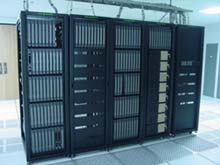Sandia demonstrates next generation high performance computing cluster

An early photo of the 128-node cluster, built by Linux Networx, that will be housed at Sandia National Laboratories in Livermore, Calif. The machine is expected to be among the world’s top-performing systems and will be used by Sandia scientists for ongoing research and development projects.
Configuration featuring InfiniBand architecture and PCI Express technology delivers performance breakthrough
Sandia National Laboratories today announced at the Intel Developer Forum it will demonstrate an Intel-based next-generation, High Performance Computing (HPC) cluster, the first such cluster to utilize PCI Express visualization systems.
The demonstration will run PCI Express Ethernet and Graphics adapters supplied by ATI on servers supplied by Linux Networx and Celestica. It will also make use of InfiniBand architecture, a new Input/Output standard network technology that holds promise for improved performance of High-Performance Computing (HPC) clusters at a lower cost.
The InfiniBand cluster demonstration utilizes 16 computers, containing a combination of Intel® XeonTM and Intel® ItaniumTM 2 processors and utilizing InfiniBand Host Channel Adapters, configured together within a 10 Gbps InfiniBand fabric. The cluster uses the Linux operating system. “We look forward to working with Intel and others to evaluate the advantages PCI Express and InfiniBand architecture’s low-latency, high bandwidth interconnect technology,” said Matt Leininger, a computational scientist at Sandia National Laboratories.
“Open interconnect standards like InfiniBand architecture and PCI Express for Intel-based systems provide outstanding performance for world class HPC clusters,” said Jim Pappas, director of initiative marketing for Intel’s Enterprise Platform Group. “Sandia National Laboratories has a long history in developing some of the most powerful clusters on the planet. We look forward to working closely with them in testing their InfiniBand cluster.”
The InfiniBand architecture simplifies and speeds server-to-server connections and links to other server-related systems in such areas as remote storage and networking devices. InfiniBand architecture’s easier connectivity, reduced latency, improved bandwidth and enhanced interoperability features increase the performance, reliability and scalability of Intel-based servers to meet the growth needs of emerging e-Business data centers.
Sandia, said Leininger, will soon begin testing the performance and scalability of the current-generation cluster. The 128-node machine, expected to be among the world’s top systems, is being built by Linux Networx and will run on 256 Intel Xeon processors at 3.0 GHz. The cluster will eventually be housed at Sandia National Laboratories in Livermore, Calif., and is powered by InfiniBand adapters supplied by Mellanox and Intel Xeon processors from Linux Networx.
The cluster, scheduled to be delivered to Sandia this week, will initially be used for InfiniBand software stack validation and hardware testing, and ultimately will be available for the lab’s internal research and development.
Sandia National Laboratories’ World Wide Web home page is located at http://www.sandia.gov. Sandia news releases, news tips, science photo gallery, and periodicals can be found at the News and Events button.
Sandia National Laboratories
A Department of Energy National Laboratory
Managed and Operated by Sandia Corporation
ALBUQUERQUE, NM LIVERMORE, CA
MEDIA RELATIONS DEPARTMENT MS 0165
ALBUQUERQUE, NM 87185-0165
PHONE: 505-844-8066; FAX: 505-844-0645
Media Contact
All latest news from the category: Information Technology
Here you can find a summary of innovations in the fields of information and data processing and up-to-date developments on IT equipment and hardware.
This area covers topics such as IT services, IT architectures, IT management and telecommunications.
Newest articles

Recovering phosphorus from sewage sludge ash
Chemical and heat treatment of sewage sludge can recover phosphorus in a process that could help address the problem of diminishing supplies of phosphorus ores. Valuable supplies of phosphorus could…

Efficient, sustainable and cost-effective hybrid energy storage system for modern power grids
EU project HyFlow: Over three years of research, the consortium of the EU project HyFlow has successfully developed a highly efficient, sustainable, and cost-effective hybrid energy storage system (HESS) that…

After 25 years, researchers uncover genetic cause of rare neurological disease
Some families call it a trial of faith. Others just call it a curse. The progressive neurological disease known as spinocerebellar ataxia 4 (SCA4) is a rare condition, but its…





















